Content
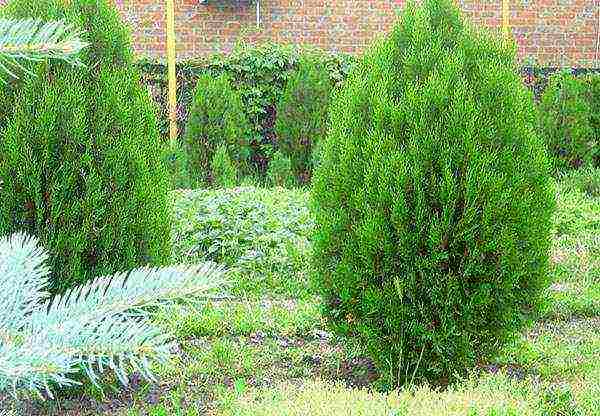 One of the five types of thuja - western, has many varieties, among which the western thuja Brabant stands out. An ornamental frost-resistant, fast-growing tree with a compact columnar crown is widely used in landscape gardening.
One of the five types of thuja - western, has many varieties, among which the western thuja Brabant stands out. An ornamental frost-resistant, fast-growing tree with a compact columnar crown is widely used in landscape gardening.
Main characteristics
 In the wild, thuja western, which is not without reason called the "life tree", grows in the eastern regions of Canada and in the north of the United States. Introduced to Europe in the middle of the 16th century, the evergreen was used to decorate parks. In Russia, thuja of this species has a wide distribution area. It is cultivated in many areas, including the Far East and Siberia.
In the wild, thuja western, which is not without reason called the "life tree", grows in the eastern regions of Canada and in the north of the United States. Introduced to Europe in the middle of the 16th century, the evergreen was used to decorate parks. In Russia, thuja of this species has a wide distribution area. It is cultivated in many areas, including the Far East and Siberia.
Having got acquainted with the description of thuja Brabant, we see that this variety is winter-hardy, withstands frosts up to 30-35 ° C. The plant is great for the harsh Russian climate. Brabant is one of the fastest growing varieties of western thuja, the growth can be 30-35 cm per year.
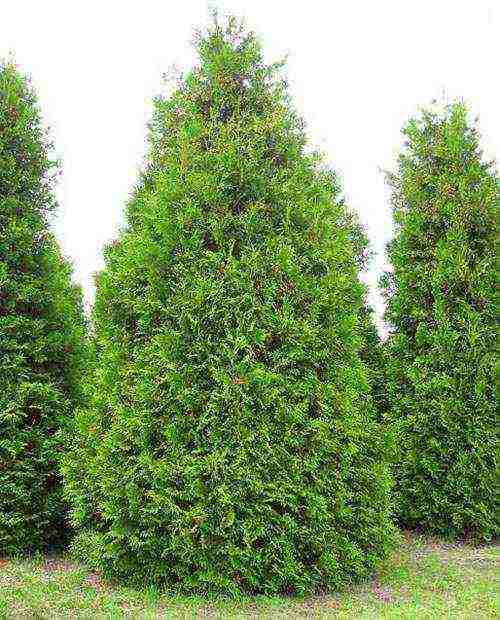 In the Russian climate, the height of Thuja Brabant does not exceed 3.5-4 meters. The shape of the crown is columnar, compact. Branches can bend down to the ground. The bark on the trunk is reddish-brown, in places it flakes off. Green needles turn brown in winter. In April-May, thuja blooms, after flowering small oblong brown cones are formed.
In the Russian climate, the height of Thuja Brabant does not exceed 3.5-4 meters. The shape of the crown is columnar, compact. Branches can bend down to the ground. The bark on the trunk is reddish-brown, in places it flakes off. Green needles turn brown in winter. In April-May, thuja blooms, after flowering small oblong brown cones are formed.
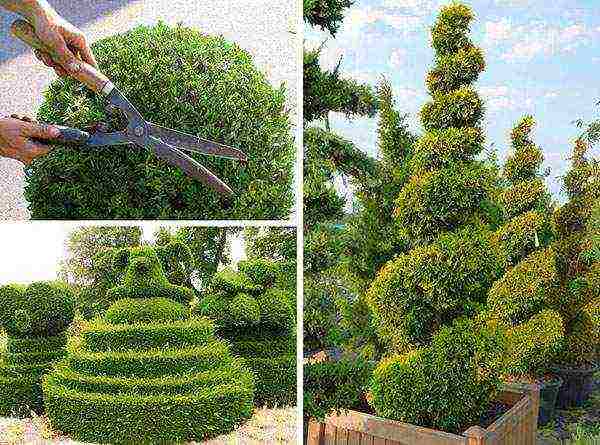 Thuja Brabant and Smaragd are very often used for the formation of hedges. Their characteristics are largely the same. Among the differences between thuja Brabant and Smaragd can be distinguished.
Thuja Brabant and Smaragd are very often used for the formation of hedges. Their characteristics are largely the same. Among the differences between thuja Brabant and Smaragd can be distinguished.
Brabant variety:
- the needles turn brown in winter;
- the shape of the crown is columnar;
- the annual growth is 35-40 cm;
- the hedge quickly grows into a dense green wall.
Smaragd variety:
- needles do not lose color in winter;
- pyramidal shape of the crown;
- annual growth - 10-20 cm;
- differs in less branching and does not require frequent haircuts.
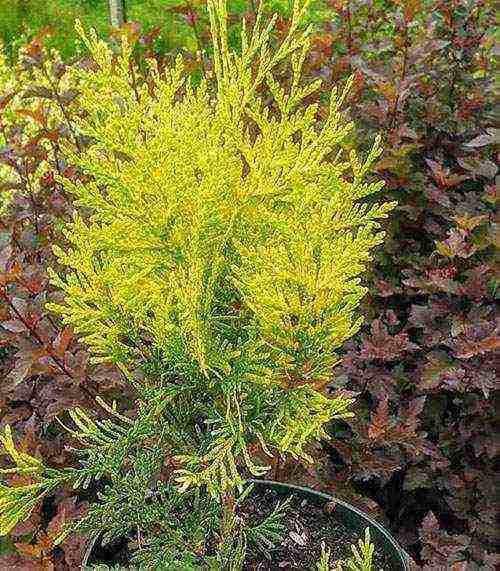 Both varieties of thuja have varieties with golden needles - Golden Brabant and Golden Smaragd. Thuja Golden Brabant is characterized by a golden yellow color, which persists in winter.
Both varieties of thuja have varieties with golden needles - Golden Brabant and Golden Smaragd. Thuja Golden Brabant is characterized by a golden yellow color, which persists in winter.
Young trees have a dense cone-shaped crown; in old trees, it becomes looser.
How to care for thuja Brabant
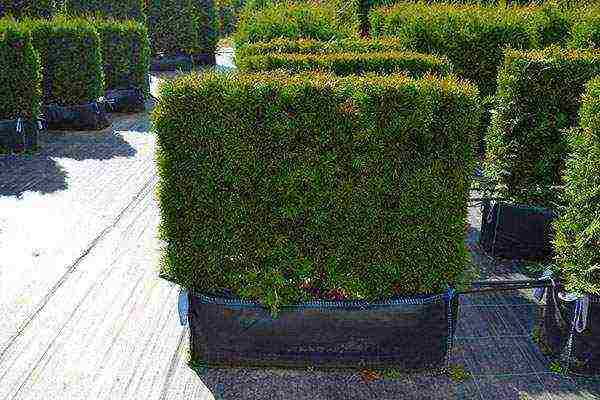 Although thuja western Brabant is unpretentious in care, it still has its own preferences for soil type, moisture, sunlight, temperature. If you neglect the basic rules when growing it, decorative functions may be lost. In particular, the main care is to periodically trim the shoots to form a beautiful crown shape.
Although thuja western Brabant is unpretentious in care, it still has its own preferences for soil type, moisture, sunlight, temperature. If you neglect the basic rules when growing it, decorative functions may be lost. In particular, the main care is to periodically trim the shoots to form a beautiful crown shape.
When cutting thuja, you can select cuttings to use for propagation. Placed in a container of water, they will give roots. Rooted seedlings can be planted in the ground.
Place and type of soil
 Thuja belongs to light-loving plants. She does not tolerate a round-the-clock shade, losing the brightness of the color of the needles. At the same time, constant heat is also harmful to her. The best option when choosing a landing site is partial shade. In suburban areas, it is advisable to plant trees on the west or east side of the buildings.
Thuja belongs to light-loving plants. She does not tolerate a round-the-clock shade, losing the brightness of the color of the needles. At the same time, constant heat is also harmful to her. The best option when choosing a landing site is partial shade. In suburban areas, it is advisable to plant trees on the west or east side of the buildings.
The most favorable soil for cultivating thuja in western Brabant is loam, although it can grow on any soil. On light soil, the plant develops better and looks more decorative. It is preferable to plant thuja in spring or autumn, but it is also possible in summer.
Landing
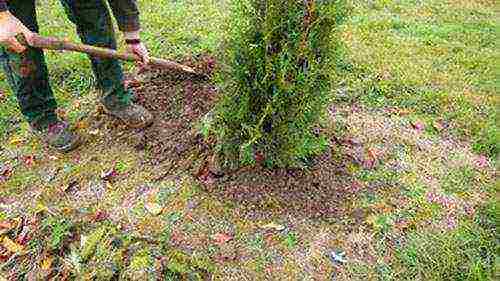 A planting pit is dug with a depth of 60-80 cm, width for the size of the root system. The pit is filled with water and moisture is allowed to be absorbed.If the soil is heavy, a drainage layer of at least 15 cm is required. The root collar is placed at ground level and the seedling is covered with a pre-prepared soil mixture. It is desirable that it includes peat, sand and leafy earth in a ratio of 1: 1: 2. To improve growth, nitroammophoska is added to the mixture. After that, the plant is watered.
A planting pit is dug with a depth of 60-80 cm, width for the size of the root system. The pit is filled with water and moisture is allowed to be absorbed.If the soil is heavy, a drainage layer of at least 15 cm is required. The root collar is placed at ground level and the seedling is covered with a pre-prepared soil mixture. It is desirable that it includes peat, sand and leafy earth in a ratio of 1: 1: 2. To improve growth, nitroammophoska is added to the mixture. After that, the plant is watered.
Care
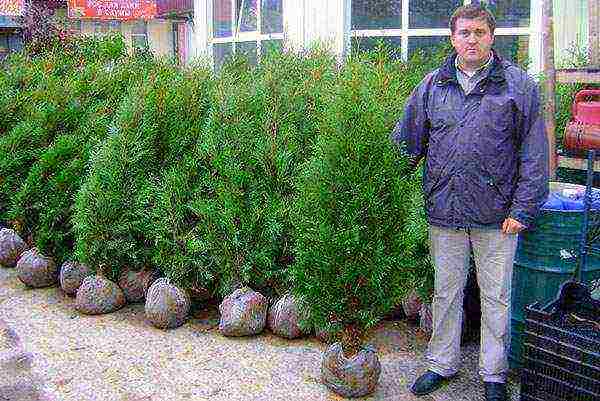 After planting, regular watering is required, about once a week. When planting in hot weather, the frequency of watering increases. The plant responds well to sprinkling. You can use a spray hose for this. In dry soil, thuja does not develop well, the needles turn yellow and crumble.
After planting, regular watering is required, about once a week. When planting in hot weather, the frequency of watering increases. The plant responds well to sprinkling. You can use a spray hose for this. In dry soil, thuja does not develop well, the needles turn yellow and crumble.
The soil should be loosened to a shallow depth, since the plant has a superficial root system. To protect the roots from drying out and overheating, it is advisable to cover the soil with mulch - peat, compost, sawdust, bark.
Thuja does not suffer from winter frosts, but in the spring it can get sunburn. Young trees should be especially protected by covering them from the sun with a material that transmits sunlight well. In an evergreen plant, the process of photosynthesis occurs even in winter. In places where heavy snowfalls occur, tree crowns are tightly pulled together with a rope for the winter.
In the first year, while the roots are not sufficiently strong, feeding is carried out up to three times per season. A year after planting, every spring, fertilizing is done with complex fertilizer. Pruning is best done 2-3 years after planting. It is preferable to do this procedure twice - at the beginning of summer and at the end of August. Small crown adjustments are made throughout the season. As you can see, planting and caring for Thuja Brabant (photo) is not particularly difficult.
The use of thuja Brabant in garden design
 The advantage of the variety is that it grows very quickly. This property of thuja Brabant is successfully used in landscape design. Thuja is a versatile element for creating a single ball, neat cone, pyramid. Non-standard single figures made of wood can be planted with any surface relief. But if beautiful geometry from Thuja Brabant or Smaragd is planned, then the landing area should have a perfectly flat plane.
The advantage of the variety is that it grows very quickly. This property of thuja Brabant is successfully used in landscape design. Thuja is a versatile element for creating a single ball, neat cone, pyramid. Non-standard single figures made of wood can be planted with any surface relief. But if beautiful geometry from Thuja Brabant or Smaragd is planned, then the landing area should have a perfectly flat plane.
Thuja western Brabant is best cut on cloudy days. This will prevent young shoots from burning in the sun, which were hidden under long branches before cutting.
Thuja planted in a row will replace the hedge. If you cut such a fence into a rectangular shape, it looks completely different. When planning to grow a hedge from Thuja Brabant, the seedlings should be dug in at a distance of about 1 m from each other, because the crown will be wide enough at the base. Over time, the crowns of trees will close, and such a hedge with a dense green curtain will hide the area from prying eyes and serve as a wonderful decoration.
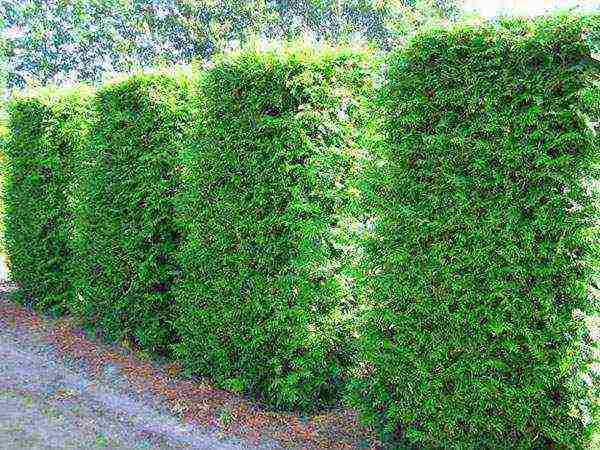 The plant begins to form when it has reached the desired height. Pruning thuja Brabant is the most time-consuming part in caring for a plant. The haircut is carried out with a sharp pruner, which will not be able to inflict dents in the place of the cut. So that the tree does not weaken, a third of the shoot should be cut.
The plant begins to form when it has reached the desired height. Pruning thuja Brabant is the most time-consuming part in caring for a plant. The haircut is carried out with a sharp pruner, which will not be able to inflict dents in the place of the cut. So that the tree does not weaken, a third of the shoot should be cut.
Thuja Brabant, like all conifers, will delight the whole year with lush greenery, purify the air, enriching it with oxygen. Another advantage is decorativeness. By combining various types of thuja with other shrubs and flowers, you can give the site a unique, inimitable shape.
Video about growing thuja Bradant
Thuja trees and shrubs are very popular among gardeners due to their lush greenery and lush crown shape. Having planted thuja Brabant and providing the necessary care for these fast-growing crops, it will soon be possible to create amazing garden compositions on the site. This popular, low-maintenance plant is used to form fairly dense green hedges that are pleasing to the eye throughout the year.
Growing conditions
Spring planting work for a representative of the cypress family is carried out when the soil is fully warmed up. In the fall, the ephedra needs at least a month for the seedling to take root before the first frost. A plant planted outdoors in August will need less watering. This is facilitated by the cool sun and frequent autumn rains.
Thuja Brabant prefers rather bright lighting, but can be in partial shade for some time. Prolonged exposure to direct sunlight leads to increased evaporation of moisture from the needles, which affects the decorative effect of the plant. It is more difficult for a dehydrated tree to survive the winter. Conifers placed in the shade will not be able to grow a dense and lush crown. It is also necessary to take care of protecting the plants from strong winds.
Advice
Young plants that have not reached a height of one and a half meters, it is advisable to hide under an awning from the hot sun, and for the winter it is useful to cover from frost with breathable covering material.
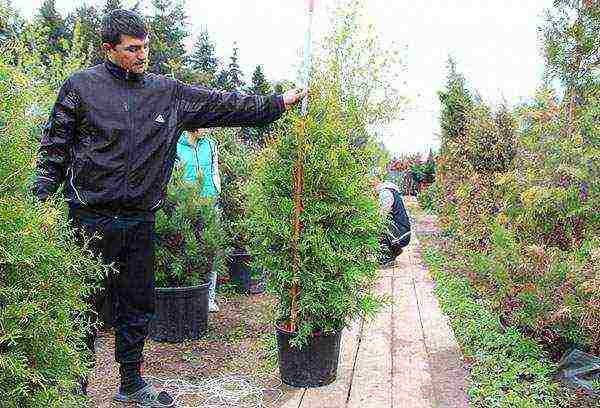
Soil preparation and planting
Thuja Brabant is undemanding to the soil composition, but a carefully prepared substrate for planting will have a beneficial effect on its rooting. Getting enough nutrients, the tree will grow a gorgeous green crown.
To obtain a fertile earthen mixture, each seedling will need:
- turf or leafy land (2 parts);
- peat (1 part);
- humus (part 1);
- sand (1 part);
- nitroammofosk (up to 500 g).
Most often, thuja western Brabant is used by gardeners and designers to create a hedge. Therefore, to obtain a fairly dense decorative wall, the distance between plants should be from 0.5 to 1 meter. To create an alley, the interval between trees is maintained from 5 to 8 m.
The size of the planting pit depends on the size of the earthen clod of the seedling, which should fit freely into it. The depth can reach 70–75 cm, the width is about a meter. When placing ephedra in heavy soil with high humidity, take care of drainage. Expanded clay or pebbles can be poured onto the bottom of the pit with a layer of up to 20 cm; broken bricks can be used. Before planting, it is recommended to dry the western earthen komtuya without disturbing its integrity.
The process of planting a decorative ephedra is not difficult.
- Part of the prepared substrate is laid on the drainage layer.
- The seedling goes deeper into the hole so that the root collar remains at ground level.
- On the sides and on top, the rhizome is sprinkled with a ready-made fertile mixture.
- The soil around the plant is compacted and spilled with water.
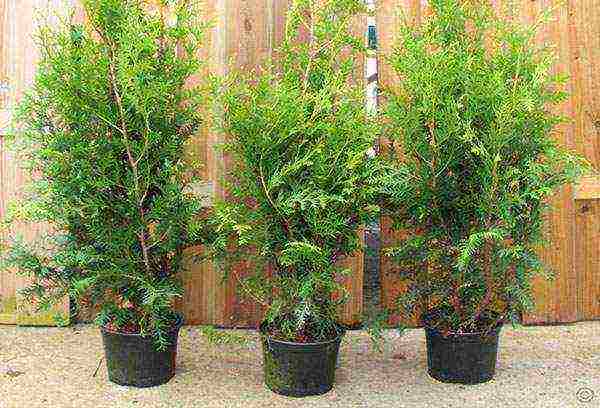
Reproduction at home
When the ephedra is propagated by seeds, the plant loses its decorative properties. Thuja Brabant is rather easily bred by cuttings. Cut woody branches at least 40 cm long will quickly take root if placed in a container of water for a while. Cuttings with roots are planted in a pot. It is not recommended to transfer a young seedling to open ground in the fall. It is better to wait until the plant gets stronger, and in the spring to transplant to the main place of growth.
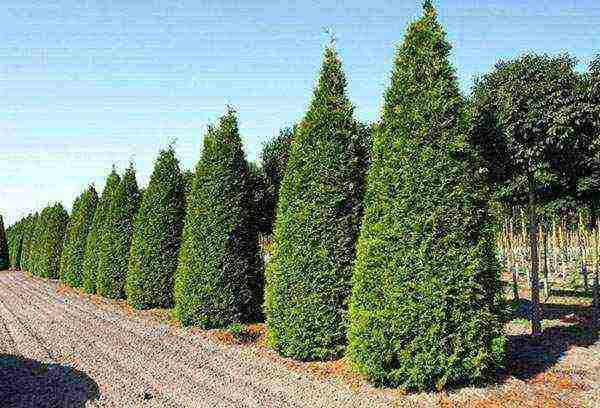
Plant care
During the first month, the ephedra requires weekly watering. Each plant consumes at least 10 liters of water. In case of prolonged drought, the amount of irrigation is increased to 20 liters per week.
Advice
Thuja needles evaporate a large amount of moisture, so regular sprinkling will have a beneficial effect on the juiciness of the green mass.
- Thuja brabant has a shallow root system, so loosening after watering should be done carefully.
- Mulching the soil with peat or compost will not only protect the roots and add the necessary amount of nutrients, but also prevent excessive evaporation of water.
- In the spring, during the first two years after planting, the plants are fed with combined fertilizers, which must include magnesium. During the summer, feeding can be repeated in June and July.
- With the onset of spring, dried and diseased shoots are removed from the thuja.
Advice
Plant branches can break under the weight of snow, so it is recommended to tie them with a rope for the winter. It is advisable to cover the roots of the ephedra with spruce branches.
It is not difficult to care for the plant at home. For western thuja grown in a pot, it is recommended to maintain the temperature regime in the range of 10 ° C to 15 ° C. Brabant prefers diffused lighting or partial shade. Timely watering, spraying of needles and plant feeding is required. In the summer, it is advisable to take the thuja pot outside in a cool shaded place.
A change in the color of the needles and the fall of damaged shoots indicate diseases that can be caused by fungi or pests. To prevent fungal diseases, it is necessary to adhere to the basic rules of planting and caring for a plant. At the first signs of diseases characteristic of conifers, it is necessary to treat Thuy Brabant with special preparations. Spraying with "Fufanon" or "Actellik" preparations is carried out in May.

A haircut
For the formation of hedges and garden compositions, the plant must be regularly trimmed. To create a dense green wall, it is enough to adjust the shape of the ephedra twice a year: at the beginning of June and at the end of August. By regularly shortening the top and trimming the side shoots, you can maintain the required height and shape of the ornamental plant.
Thuja Brabant remarkably tolerates pruning, which is carried out from the third year of life. Powerful pruning shears should evenly cut off the tops of the branches, without unduly injuring them. Only a third of the shoot is cut, so that the plant does not weaken.
Advice
The pruning procedure is recommended on a cloudy day so that the needles do not turn yellow from sunburn. At the end of the cut, the plant must be watered.
Among landscape designers, thuja western Brabant is deservedly very popular. A fast-growing, frost-resistant and unpretentious coniferous plant is increasingly becoming a decoration for private gardens. The lush dense crown, which has a pyramidal shape, is very decorative. It looks spectacular both in combined compositions and in alleys and hedges.
Using this representative of the cypress family to create a stylish cozy garden will limit the space, giving it a decent frame.
Rare landscape design of a personal plot or park does without a popular, rich and simply beautiful plant - thuja. She fell in love with many for the wonderful aroma of needles, pliability to the haircut and, of course, for the bright greenery, pleasing with its purity and freshness all year round. This plant of the cypress family has 5 species of its kind:
- thuja Korean;
- thuja western;
- thuja is giant;
- thuja japonica.
Thuja western Brabant is perhaps one of the most preferred conifers by gardeners.
Description of the variety
Thuja Brabant is one of the varieties of thuja western, with a conical crown shape... Its distinctive feature is its rather fast growth and evergreen needles. The annual growth of the tree averages 30 cm in height and 10 cm in width.
Western thuja came to us from the Atlantic coast of North America, where in natural conditions the plant grows up to 20 m in height. In our latitudes, thuja Brabant reaches a maximum of 4 meters.
The plant blooms in April - May, the cones are small, only 1 cm, oval or ovoid.
Advantages and disadvantages
Many domestic amateur gardeners and landscape designers prefer this particular variety of thuja due to the following advantages:
- fast growth;
- unpretentious care;
- frost resistance;
- ease of reproduction;
- suppleness to the haircut.
However, due to such a rapid growth, the plant will have to be trimmed 2-3 times a year.Thuja, although generally unassuming to its content, however, at first after planting requires care and regular abundant watering, up to three times a week.
Also, a young plant in winter will need to be covered, and so that lumps of sticky, wet snow do not spoil the shape of the tree, tie the branches to the trunk with twine or rope.
How to properly land in the open field
The key to successful planting in the open ground of thuja western Brabant lies in the observance of several conditions:
- it is necessary to choose the landing time correctly;
- choose a planting site favorable for the plant;
- prepare an auxiliary substrate for the soil;
- correctly plant a plant in open ground, taking into account all the features of its growth and development.
1. Timing of boarding
It is better to plant thuyu Brabant in open ground in the spring, but it is also possible in early autumn. It should be noted that the plant must be planted at least a month before the onset of the first frost, so that the tree has time to take root safely.
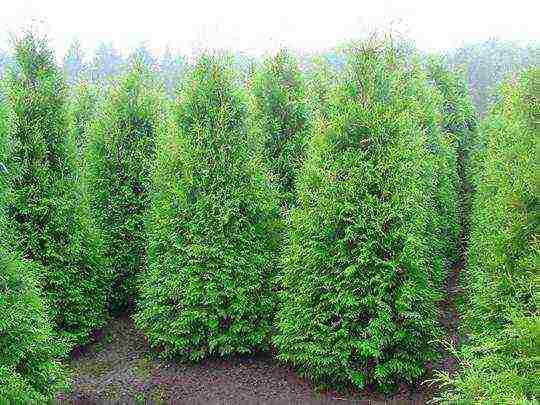
2. Site selection and soil preparation
To grow a healthy, beautiful tree, with lush, frequent needles, it is better to choose a planting place that is not very shaded, but it will not be comfortable in the bright sun throughout the day. Light partial shade of the waters is the key to success in choosing the location of this plant.
Thuja Brabant, in principle, can grow in any soil, but in a nutritious, pre-prepared substrate the plant will feel much better, take root faster, and will delight with its rich greenery all year round.
To prepare nutrient soil for planting thuja, you should take two parts of the earth, and one part each of sand, peat, humus. Gardeners also recommend pouring 500 grams of nitroammophosphate into the hole under each tree.
3. The process of planting in open ground
Before planting the plant in the ground, the roots should be slightly dried without destroying the earthen coma on them. The width and depth of the planting hole depends on the size of the root system of the plant; on average, you need to dig a depression meter by meter.
Pour drainage from broken bricks or expanded clay at the bottom. Deepen the seedling, sprinkling and tamping it with soil, while the root collar should be flush with the ground, and the roots and trunk of the tree should not change their location. Within a month after planting, the plant must be watered quite often at the rate of 10-15 liters per week.
Reproduction

There are two ways to propagate thuja western Brabant at home:
- seeds;
- by cuttings.
Woody 2-3 year old shoots are suitable as cuttings. Cut them in the spring, about 40 cm long. The cuttings are placed one by one in a jar of water until roots are formed. With the appearance of the roots, the cutting is planted in a pot, and in the fall it can already be transferred to open ground for wintering.
When planting a stalk, you need to place it in a hole so that the leaves at the base are at least 5 cm above the soil level. After the thuja stalk is planted, it should be thoroughly watered, adding soil if necessary if it shrinks.
Around the planted plant, 3 pegs are installed and tied with a ribbon, so that in windy weather the young tree sways, thereby strengthening the trunk, but at the same time it does not break.
While the root system is forming and developing, the thuja of western Brabant requires regular watering. In the future, the tree will need to be watered only in dry, hot weather. Care
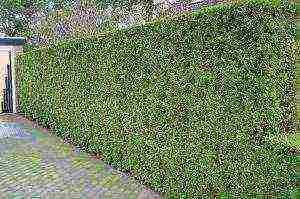
When buying a thuja western Brabant seedling in a store, experts recommend paying attention to the following points:
- The condition of the needles of the plant. If the twigs become fragile and break off at the slightest touch, and the needles fall off, then, most likely, the plant has died. The thing is that after death, the tree can retain its original appearance for up to 3 weeks.
- You should not buy thuja if the soil in its pot is completely dry. If the earthen coma in the plant dries out too much, irreversible consequences may begin, and it will no longer be possible to "cast off" it, as is the case with deciduous trees.
- If possible, you need to carefully examine the roots of the plant, the tips of the root should be light and always juicy.
1. Soil and fertilizers
Thuja western Brabant is absolutely not pretentious to the soil. For its development and growth, both peat and loamy soil, dry sandy loam are suitable. The main condition is for the substrate to be permeable. The soil is heavy and dense will contribute to the development of root rot in thuja.
Thuja needles constantly evaporate a large amount of moisture, so it is necessary to ensure that the soil does not dry out. The plant needs not only to be watered, it is also desirable to irrigate the crown with water.
Thanks to this, dust is washed off, and the tree can breathe easier, which contributes to an improvement in the general condition and intensity of the physiological processes of the plant.
To prevent overheating and drying out of the soil, the trunks are mulched with peat, compost or wood chips.
2. Top dressing
The plant should be fed in March, if necessary, repeat at the beginning and in the middle of summer.
It is better to use a compound fertilizer bought in a store. If mineral fertilizer was applied during planting, then in order not to burn the roots, it is better to carry out the next dressing no earlier than two years later.
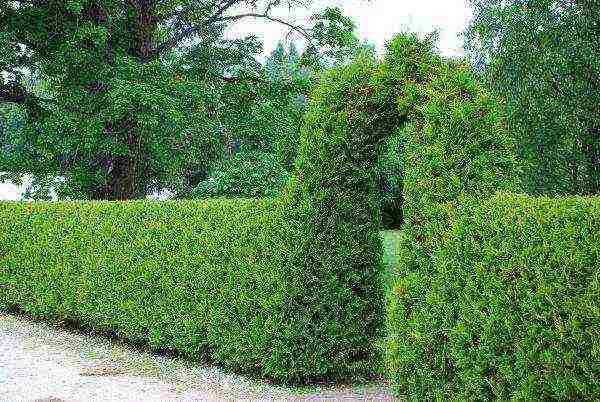
3. Diseases and pests
Tui Brabant usually has diseases such as:
- decay of roots;
- trunk rot;
- mold.
All these diseases, as a rule, are caused by fungi, and they indicate poor quality plant care. Since the disease is not very noticeable at the initial stage, it is recommended to inspect the plant more often. The signal for the beginning of the treatment of thuja can be various raids on the branches of a tree, as well as a change in the color of the needles.
In addition, various pests can also cause the disease:
- sucking - aphid, thuja false shield, spider mite;
- pine-eating - leaf roll, speckled moth;
- other root and stem pests - thuy bark beetle, scale insects, false scales.
A haircut
In order for thuja Brabant to please with its lush, dense, green crown, the plant needs to be cut regularly, otherwise the tree will look loose and ugly. The necessary shape should be given immediately after planting, and then only corrected. To achieve a dense and dense hedge, melt
Brabant is pruned in March and August. When cutting a plant, you must follow the following rules:
- Cut with a firm hand, cutting more branches for a thicker crown.
- By cutting off the branches, leave a part of the young shoot.
- A cloudy day is better suited for a haircut, this will help to avoid yellowing of the needles due to sunburns received by thuja during the increased evaporation of moisture release.
- Be sure to water the thuja after pruning.
Price
The price of thuja western Brabant in shops and nurseries largely depends on the height and condition of the plant and varies between 300-400 rubles for a small seedling, and 1500-4000 for an adult tree.
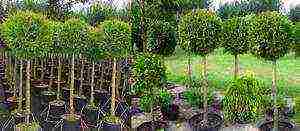 Thuja western includes several varieties, the most popular of which are: Brabant, Smaragd, Danica, Golden Globe, Columna and others. One of the most beloved by gardeners is thuja western Brabant. This plant is a real decoration of city parks, squares, and, of course, personal plots.
Thuja western includes several varieties, the most popular of which are: Brabant, Smaragd, Danica, Golden Globe, Columna and others. One of the most beloved by gardeners is thuja western Brabant. This plant is a real decoration of city parks, squares, and, of course, personal plots.
Description of thuja Brabant
The tree grows rapidly, surpassing in speed the similar to it smaragd, and yielding in this indicator only to larch. But, unlike her, thuja Brabant remains evergreen, since it does not shed its foliage for the winter. In height, this type of thuja grows up to 20 m, and the diameter of the crown - up to 4 m. The trunk of the tree is reddish-brown in color, often exfoliates, the cone-shaped branchy crown descends to the ground. This form of Brabant allows you to form beautiful geometric shapes from plants. A lonely growing thuja can give a spherical shape, a strict cone or a pyramid, and from the plants planted in a row, get a fence in the form of a large rectangle.
Thuja needles are green, sometimes with yellowish tips. Unlike similar plants, it does not change color with the onset of cold weather, which is a rare and valuable property.
This type of thuja belongs to the cypress family and is a real giant among fellow tribesmen. Scaly needles up to 0.5 cm in size occupy a vertical position, firmly pressing against the shoot. Every 2-3 years, the needles are renewed along with the twigs... Oval-shaped cones up to 12 mm in size are a set of plates with two flattened seeds attached to them. Each seed has two wings, allowing it to travel considerable distances under the influence of the wind.
During the year, thuja grows in size: 25–30 cm in height, 8–10 cm in width. Brabant has a compact root system. The trunk of the tree is strong, does not give in to rot, with a delicate pleasant scent.
Light-loving plant, he likes to be in sunny places, although the shade is not an obstacle to his growth. Close groundwater and highly moist soil have a beneficial effect on the thuja.
Adult, mature plants are quite tolerant of dry weather and frosty winters.
Easily taking the desired shape, the crown allows you to use Brabant in landscape design both as single-planted plants and group compositions.
Thuja Brabant - planting and care
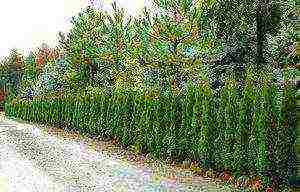 When buying Thuja Brabant seedlings, you should pay attention to the fact that they have already passed acclimatization and occupy a separate container with the presence of fertilizers. This allows you not to damage the roots, as in the case of digging up plants, and then the thuja will definitely take root. Fresh seedlings are distinguished by bright, juicy and green needles, as well as strong, light roots, having a thickness of 1–3 mm. Shoots of brown and yellow color are a sign of a diseased plant. For successful survival, the size of the acquired plant should be in the range of 20-100 cm.
When buying Thuja Brabant seedlings, you should pay attention to the fact that they have already passed acclimatization and occupy a separate container with the presence of fertilizers. This allows you not to damage the roots, as in the case of digging up plants, and then the thuja will definitely take root. Fresh seedlings are distinguished by bright, juicy and green needles, as well as strong, light roots, having a thickness of 1–3 mm. Shoots of brown and yellow color are a sign of a diseased plant. For successful survival, the size of the acquired plant should be in the range of 20-100 cm.
When disembarking thuja Brabant, certain rules must be observed:
- The best time for planting is April - May. It is possible to plant seedlings from spring to autumn, and with a high degree of probability all plants will survive, but spring specimens will provide more active growth and the absence of diseases.
- When choosing a site desired for planting a thuja, it should be borne in mind that the plant prefers light and moist soil. In heavy or dry soil, the thuja will wither and turn yellow. It is important to place Brabant in a place where the balance between light and shadow will be maintained, and the effect on it of the wind will not become critical. If the plant is planned to be planted near buildings, then it will be correct to place the thuja to the east or west of them, thus, the combination of sunlight and shade will be optimal.
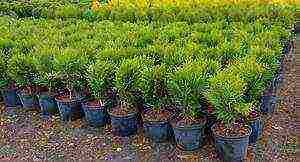 When preparing the soil for planting, it is necessary to dig holes measuring 60x60 cm in length and width and 80 cm in depth. If the soil is dense and heavy, then a drainage 20 cm thick should be laid on the bottom of the pit, using broken brick, large rubble or pebbles for this. As a nutrient mixture, you can use the following proportion: 1 part of land and two parts of sand and peat, respectively. When planting in the spring, complex fertilizers in the amount of 200 g are added to the pit, in summer and autumn - superphosphate (250 g).
When preparing the soil for planting, it is necessary to dig holes measuring 60x60 cm in length and width and 80 cm in depth. If the soil is dense and heavy, then a drainage 20 cm thick should be laid on the bottom of the pit, using broken brick, large rubble or pebbles for this. As a nutrient mixture, you can use the following proportion: 1 part of land and two parts of sand and peat, respectively. When planting in the spring, complex fertilizers in the amount of 200 g are added to the pit, in summer and autumn - superphosphate (250 g).- If the thuja will form a composition in the future, then when planting it is important to observe the required distance between the seedlings. They should be located within a range of 0.5–3 m from each other.
- After completing all the preparatory procedures, it is necessary to place the thuja so that the neck of the seedlings is at ground level, and fill the roots with the prepared mixture, and then tamp it loosely.
These are general recommendations for planting both thuja western Brabant and Smaragd and other varieties of the family. If it was decided to plant plants in the autumn, then you need to meet this by October... You can extend the planting period until Novemberif the base was in the container. In autumn, you should use only top dressing that stimulates root growth, and mulch can be used to warm them. The crown of a young plant must be protected from the upcoming cold weather.
Growing thuja Brabant
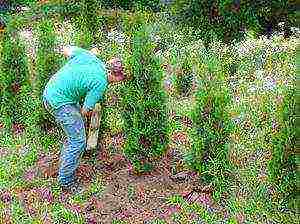 So that thuja grows healthy and beautiful, you need to provide her with appropriate care, which is not an easy task for the owners, because it is necessary to organize all the necessary work on time: feeding, mulching, timely watering, correct pruning and cutting.
So that thuja grows healthy and beautiful, you need to provide her with appropriate care, which is not an easy task for the owners, because it is necessary to organize all the necessary work on time: feeding, mulching, timely watering, correct pruning and cutting.
Loosening, mulching and watering
After planting seedlings, water them abundantly, then mulch the soil 10–15 cm in diameter from the trunk, so the soil will not dry out and overheat, and the mulch, gradually overheating, supply the plant with nutrients. In winter, the roots of the thuja will be protected from frost, and the earth will not be compacted. For mulching, you can use peat, bark, shavings, compost, rotted foliage. The most important and stressful months to care for are the first months after planting. At this time, it is recommended to water the plant every day, which will allow the roots and young shoots to be protected from a lack of moisture. It will be useful to periodically loosen the ground near the plant to a depth of 10-15 cm.
Top dressing
For Brabant, as for all members of the family, timely fertilization is of great importance. In the case of spring planting of the plant, it is recommended to feed it with phosphorus-potassium fertilizers in September, and in the beginning of spring to apply dry top dressing "Kemira-universal". After two weeks, the event is repeated, and autumn is again the time for phosphorus-potassium mixtures. This procedure should be repeated from year to year..
Pruning and trimming
Sanitary pruning of western thuja is usually done in June, when they get rid of diseased and damaged branches, if possible, cutting them off by no more than 1/3... And here is the haircut of the plant in order to give it the desired shape, it is carried out twice a year: in early spring and early autumn. For this procedure, a pruner is used, and if the volume of work is large, special garden equipment is used.
Preparing for winter
 In preparation for the cold weather, the crown of thuja Brabant is tied with a rope, the plant becomes more compact and more easily tolerates the effects of snow and wind. Young trees can be covered with spruce branches, non-woven covering material or kraft paper.
In preparation for the cold weather, the crown of thuja Brabant is tied with a rope, the plant becomes more compact and more easily tolerates the effects of snow and wind. Young trees can be covered with spruce branches, non-woven covering material or kraft paper.
Plant care - it's not easy, but interesting, and the result of this work is often a matter of pride for gardeners.
Diseases and pests
Tuyu Brabant, like other plants, does not bypass the side of the disease. Below is a description of the main diseases and pests:
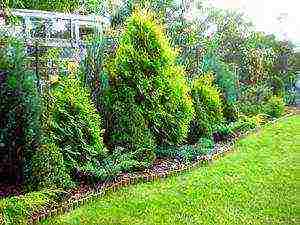 Fungal diseases. A sign of fungal diseases is the brown shoots appearing on the tree. It is necessary to remove and burn such branches immediately so as not to transfer the fungus to other parts of this or neighboring plants. A diseased tree should be treated at intervals of two weeks with a 0.2% Fundazol solution until mid-autumn. In order to prevent fungus, limestone can be added to the roots of thuja.
Fungal diseases. A sign of fungal diseases is the brown shoots appearing on the tree. It is necessary to remove and burn such branches immediately so as not to transfer the fungus to other parts of this or neighboring plants. A diseased tree should be treated at intervals of two weeks with a 0.2% Fundazol solution until mid-autumn. In order to prevent fungus, limestone can be added to the roots of thuja.- False shield. Both adult insects and larvae harm plants by sticking to leaves and stems. The main danger lies in the ultra-rapid reproduction of pests, which are able to cover a significant area within a few days. The diagnosis of this disease can be made by the yellow spots that have begun to appear on the tree trunk. It is necessary to come to the aid of the plant in time, using "Rogos" or "Carbofor" for spraying.
- Thuvaya finger-ring moth. The beginning of May is the time of the mass flight of these small butterflies. If they chose thuja as their place of settlement, then this can be determined by the death of the upper parts of the shoots and the needles that take brown color. To avoid the dispersal of moths, in the middle of summer the plant should be treated twice (with an interval of a week) with substances containing pyrethroids, for example, "Cypermethrin".
- Thuvaya aphid. These pests settle in colonies on the back of the shoots.Sucking insects are capable of damaging the needles, which at the same time begin to turn yellow and fall off, thereby disrupting the decorative effect of plants. The way to combat thuja aphids is the treatment of Brabant with Karbofos.
The use of thuja in landscape design
The use of this tree in landscape design is diverse, and often depends on the personal preferences of gardeners. Let's highlight the most popular solutions:
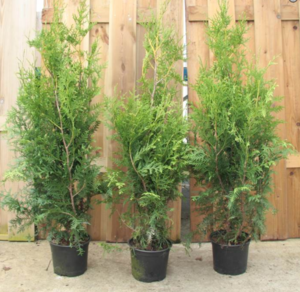 Thuja is a fast-growing plant, so the decision to create a hedge from several members of the family will be quite justified.
Thuja is a fast-growing plant, so the decision to create a hedge from several members of the family will be quite justified.- Urban conditions with increased gas content do not interfere with plant cultivation. Therefore, the described type of thuja can be successfully used in landscape design of both parks and squares, and personal plots.
- Thuja goes well with other members of the family, for example, Smaragd, as well as other cypresses, some types of pines, larch trees and some other plants. In combination with other trees and shrubs, thuja allows you to create very interesting and original compositions.
- From a lonely thuja tree, you can make a real work of gardening art, giving it the most unusual forms.
- Trees planted in a row can form a scenic hedge. Moreover, both clipped plants and free-growing plants are used, but a neat clipped form is more suitable for Thuja Brabant. Intertwining with each other, the branches of the trees form a solid green wall, opaque to prying eyes.
With proper care, thuja withIt is able to please owners for many years with a luxurious and stylish look, both as a single plant and as part of a composition.
>


